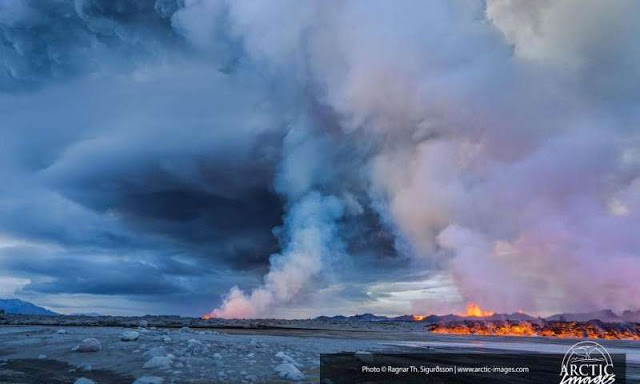
It has long been suspected that sulfur emissions can brighten clouds. Water droplets tend to clump around particles of sulfuric acid, causing smaller droplets that form brighter, more reflective clouds.
But while humans have pumped sulfur into Earth’s atmosphere since the Industrial Revolution, it’s been hard to measure how this affects the clouds above. New University of Washington research uses a huge volcanic eruption in Iceland to measure the change.
The new study, to be published in Geophysical Research Letters, a journal of the American Geophysical Union, shows that sulfur emissions do indeed result in smaller cloud droplet size, leading to brighter clouds that reflect significantly more sunlight.
“This eruption is a chance to nail down one of the big uncertainties in climate models,” said first author Daniel McCoy, a UW doctoral student in atmospheric sciences.
The study takes advantage of a unique geologic event. During six months from summer 2014 until early 2015, a crack in the Bardarbunga volcano seeped lava and sulfur gas. This was not one of Iceland’s huge explosive eruptions that fill the skies with ash and shut down airplane routes. Instead it was a long, slow, low-elevation seep of sulfur emissions that produced an amount of lava second only to Laki in the recent history of Iceland eruptions.
The UW researchers looked at data for that region recorded by NASA’s MODIS, or Moderate Resolution Imaging Spectroradiometer, instrument to measure the size of droplets in the marine cloud layer. While the volcano was spewing sulfur, the droplets were the smallest in the 14-year record of observations.
“You can see the effect over an entire ocean for a two-month period,” McCoy said. “It was a pretty unique geophysical event within the satellite record.”
The results confirm that volcanoes cool the planet not just by emitting particles high in the atmosphere, but also by releasing low-level sulfur to influence cloud formation.
When the air contains aerosol particles, the same amount of water vapor condenses into many small drops, whose larger surface area reflects more sunlight. The difference in reflected solar radiation for September and October 2014 was 2 watts per square meter in the region over Iceland.
“The effect of volcanic emissions on clouds has been a difficult one to quantify because of the ephemeral nature of most events,” said co-author Dennis Hartmann, a UW professor of atmospheric sciences. “This eruption provides a natural laboratory that lets us test how clouds respond to aerosols.”
The results may help understand humans’ impact on clouds. Human pollution since the Industrial Revolution is believed to have altered skies in the Northern Hemisphere. One uncertainty in climate models is how much human pollution has brightened the clouds, shielding the planet from the effects of the simultaneous rise in carbon dioxide.
“One of the big uncertainties regarding climate change is how much human-produced aerosols have offset the warming until now,” Hartmann said. “We hope the data from this eruption will improve the model simulations of cloud effects, and narrow the uncertainties in projections of the future.”
The most recent Intergovernmental Panel on Climate Change report was the first to include a chapter on clouds and aerosols, one of the biggest uncertainties in global climate models. This study will provide a benchmark for modelers to check their simulations of clouds and aerosols and improve their algorithms for the next generation of climate models.
“The same way that the Mount Pinatubo eruption in 1991 was a big on-off signal that allowed us to evaluate models’ response to volcanic forcings, I think this Iceland eruption is a unique event that will help us to better understand the interaction between aerosols and clouds,” McCoy said.
Reference:
Daniel T. McCoy and Dennis L. Hartmann. Observations of a substantial cloud aerosol indirect effect during the 2014–2015 Bárðarbunga-Veiðivötn fissure eruption in Iceland. DOI: 10.1002/2015GL067070
Note: The above post is reprinted from materials provided by University of Washington.









